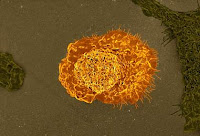In the past decade, researchers have discovered a network of cells and vessels in and around the mammalian brain that help remove cellular waste and debris. Studies in mice found that, as the function of this system declines with age, toxic compounds can build up in the brain.
The brain also has its own population of immune cells. As in the rest of the body, these cells patrol for invading pathogens. They also help with tissue maintenance and repair.
PBM immune cells clear waste
An NIH-funded research team led by Drs. Antoine Drieu and Jonathan Kipnis from Washington University in St. Louis has been studying a key type of immune cell, called parenchymal border macrophages (PBMs), that interacts with the cerebrospinal fluid that flows in and out of the brain. Their new study was published on November 9, 2022, in Nature.
To see if PBMs may have a role in regulating the flow of cerebrospinal fluid, the researchers used fluorescent tracers to examine the brains of mice. They found PBMs closely associated with the tracers moving in and out of the brain in cerebrospinal fluid. The researchers also identified different types of PBMs, one of which serves as a waste scavenger.
When the team injected mice with a drug that depleted PBMs, the flow of cerebrospinal fluid through the brain was substantially reduced one week later.
When they tracked cerebrospinal fluid flow in real time in the mice using magnetic resonance imaging, they saw similar results. The researchers also saw buildup of several proteins that have been associated with Alzheimer’s in the mice with depleted PBMs.
Brains need PBMs
Further work showed that, when the brain lost PBMs, the activity of enzymes called MMPs also decreased. This led to accumulation of extracellular matrix along vessels and capillaries.
Extracellular matrix provides structure for the vessels that carry fluid through the body. But too much can make vessels overly stiff, impeding fluid flow.
Correspondingly, the researchers found that vessels in the brains of mice with depleted PBMs didn’t expand normally.
Aging reduces PBMs
The team next compared PBM levels in young and aged mice. Aged mice had fewer of the scavenger PBMs. Aged mice also had a greater accumulation of extracellular matrix in the brain.
When the researchers injected aged mice with a substance that can activate PBMs, levels of MMP enzymes and fluid flow both increased, while the amount of extracellular matrix decreased.
When the researchers depleted PBMs in a mouse model of Alzheimer’s, those mice developed more amyloid beta plaques — one of the hallmarks of the disease — than the same type of mice with normal levels of PBMs.
Finally, the team looked at immune cells collected from the brains of people with an inherited form of Alzheimer’s. The PBMs from people with the disease had changes in gene expression that reflected decreased function compared with unaffected family members.
“Cerebrospinal fluid flow is impaired in numerous neurodegenerative diseases, such as Alzheimer’s, stroke, Parkinson’s, and multiple sclerosis,” Drieu says.
“If we can restore fluid flow through the brain just by boosting these macrophages, maybe we can slow the progression of these diseases.” More work in animal models will be needed before such an approach could be tested in people.
SOURCE:
REFERENCE:
- Drieu A, Du S, Storck SE, Rustenhoven J, Papadopoulos Z, Dykstra T, Zhong F, Kim K, Blackburn S, Mamuladze T, Harari O, Karch CM, Bateman RJ, Perrin R, Farlow M, Chhatwal J; Dominantly Inherited Alzheimer Network, Hu S, Randolph GJ, Smirnov I, Kipnis J. Parenchymal border macrophages regulate the flow dynamics of the cerebrospinal fluid. Nature. 2022 Nov 9. DOI: 10.1038/s41586-022-05397-3. Online ahead of print. PMID: 36352225











